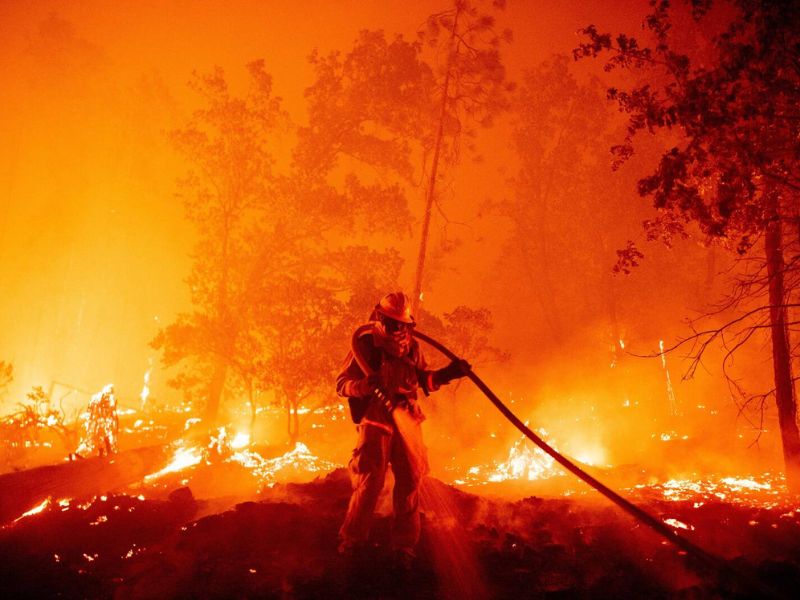Oregon Wildfires: Cooler Weather Brings Relief Amidst Ominous Forecasts
A brief break from the strongly, dry warm on Monday gave a little help for Oregon’s eight major fierce blazes, incidentally ending their fast spread. Be that as it may, the viewpoint remained bleak as the state braced for challenging climate conditions and invited fortifications from other states and Canada.
The biggest of these rapidly spreading fires, the Dairy Animals Valley Fire, had inundated 132,528 sections of land by Monday and was as it were 5% contained along its sprawling 163-mile border. This fire, burning within the state’s inadequately populated eastern locale, was announced a “megafire” after it outperformed the 100,000-acre stamp over the end of the week.

The winds that had been fueling the Bovine Valley Fire’s savage development passed on early Monday, giving firefighters a much-needed opportunity to form progress. This brief quiet within the climate advertised a flicker of trust for control endeavors, agreeing to a day-by-day overhaul from the U.S. Woodland Benefit and state fire authorities.
In reaction to the basic fire conditions, Senator Tina Kotek expanded Oregon’s state of crisis on Monday. Fair days prior, she had conjured the state’s Crisis Fire Act to mobilize extra assets for the Dairy Animals Valley Fire, which touched off final Thursday.
“Rapidly spreading fires are dynamic over Oregon and are developing at a concerning pace,” Kotek said in an explanation. “Hot and blustery conditions this end of the week, counting forecasted lightning in a few regions, are debilitating indeed bigger rapidly spreading fires.”
South of the Bovine Valley Fire, the Bonita Fire, covering 2,275 sections of land, was 40% contained as of Monday. Both fires were beneath the administration of a government assignment drive, and both were regarded as human-caused, even though the precise causes and those mindful remained beneath examination.
Endeavors to combat the fires were fortified by two Oregon State Fire Marshal assignment powers and help from two errand powers from Washington state. The cooler climate on Monday, due to a high-pressure framework shifting eastward, permitted these assignment strengths to be reassigned to other fires.

Clearing availability levels were minimized in a few regions close to the Bovine Valley Fire, even though inhabitants of the Westfall region were still prompted to arrange for a prompt departure. The Malheur District Sheriff’s Office kept up a “get prepared” status for the locale.
Extra assets were being dispatched from different states, including Gold Country, Colorado, Florida, Georgia, Hawaii, Idaho, Montana, Unused Mexico, Oklahoma, and Texas. Back moreover came from Canadian territories such as Alberta, British Columbia, Saskatchewan, and the Yukon and Northwest Regions.
Oregon’s second-largest fierce blaze, the Falls Fire in Malheur National Timberland, had burned 64,225 sections of land by Monday and was however to be contained. Solid winds, anticipated to reach up to 20 mph, postured a noteworthy challenge to firefighting endeavors. The fire provoked required clearing orders in parts of Terrific and Harney districts, and U.S. Highway 395 close Riley was closed as flames drew closer.
Must Read:
- King Charles III’s Exciting Visit to Australia and Samoa During Cancer Recovery
- Avery Street Civil War Hospital Building Purchased for Renovation
Collectively, Oregon’s eight major fires had expended roughly 250,000 sections of land by Monday. The state detailed that four people had been harmed, and four structures were crushed within the Dairy Animals Valley Fire and Falls Fire.
Looking ahead, the National Weather Service in Portland cautioned that temperatures would rise once more all through the week, with inland zones possibly coming to highs of 95 degrees by the end of the week. Furthermore, there was a 10% to 20% chance of lightning beginning Tuesday, worsening fire dangers. A ruddy hail caution was in impact for dry conditions and conceivable lightning strikes from northern California to Medford, Oregon.
The National Interagency Fire Center encouraged caution for inhabitants and travelers alike. “We cannot halt the hot climate and lightning storms, but we ready to do our portion to be fire-wise when we are reproducing, traveling, or remaining domestic,” it expressed in its day-by-day report. The center suggested remaining educated about climate conditions and fire perils in both private regions and excursion spots to relieve dangers amid the fire season.

